Subtleties of keeping fish cockerel and basic recommendations for care

A bright beautiful cockerel fish will decorate any aquarium. In addition to her peculiar appearance, she has an energetic and belligerent demeanor. Caring for fish, although simple, has some subtleties.

Peculiarities
For its cocky character, the cockerel fish was nicknamed the fighting fish. The aquarium fish is a representative of the macropod family. This labyrinth fish has an interesting feature - it requires air to breathe.
The oval and elongated body of the cock is flattened on the sides and does not differ in large size: in males it reaches 5 cm, and in females - about 4 cm. An unusually beautiful look is given to the cock by its fins, which in different species have a slightly different size, appearance and outline of the border.
Basically, the fins - both the caudal and the upper - are rounded, and the ventral fins are pointed.
Females have shorter fins than males, and they have less bright color and less beautiful shape.
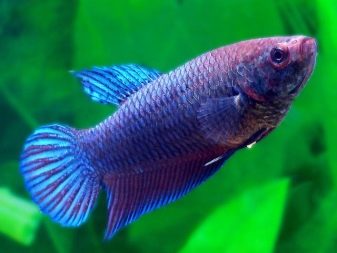
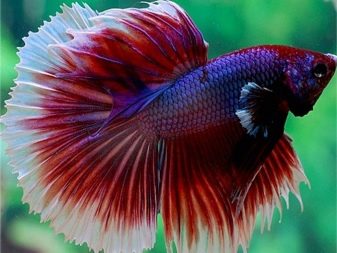
One of the features of this fish is its amazing and unique color. It can be not only one or two colors, but also multicolored: contain shades from blue to purple, from green to yellow, from orange to red, as well as white and black.
In males, the color is somewhat brighter than that of females, and has a feature that under strong light during spawning and during fights, their color becomes even brighter. Males are classified according to the size and shape of their fins, as well as by color: one-color, two-color, multi-color.
The behavior of cockerels is characterized by cockiness and aggressiveness not only in relation to other types of fish, but also to their relatives. Keeping two males in a small aquarium can kill the weaker one. However, despite their aggression, male males have a strong parental feeling.
These fish live for about three years. Caring for them is not particularly difficult even for beginners, although it has some nuances.

How to equip an aquarium?
Fish can perfectly exist not only in large, but also in small aquariums. It is only necessary to take into account that one cockerel will need from 3 to 4 liters of water. One cockerel can even be kept in a 3-liter jar, and for several individuals a container with a volume of 10 to 20 liters is required.
Containers can be of various shapes: cockerels live in rectangular, square and round aquariums. It is recommended to divide large tanks into several zones with partitions. This will allow you to keep several male cockerels in one aquarium without risking their life.
Safe environmentally friendly material is used for partitions. They must have holes for free circulation of water. It is advisable to plant tall aquatic plants near the fences. They will cover the review and exclude unnecessary contacts.
In addition, the plants give a beautiful appearance and also serve to form spawning nests. They also contribute to the enrichment of the aquatic environment with oxygen and maintain its biological balance.
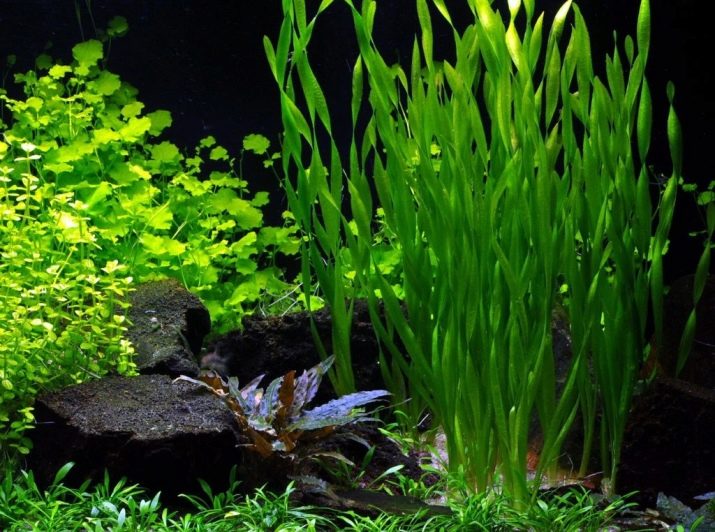
In addition to living ones, artificial plants can also be used for decoration, but they should not have sharp outlines so that the fish do not damage the fins.
It is recommended to place soil in the form of river small pebbles, gravel or coarse sand at the bottom of the container. This neutral soil contains beneficial microorganisms necessary for the processing of the products of the vital activity of aquatic life.
And you can also place different driftwood, large stones, equip grottoes that will serve as a shelter for fish. These decorative elements must be environmentally friendly and not have sharp edges.

Aeration of the water is not so important for the cock, as they additionally use air for breathing. But temperature drops in water adversely affect the males, so it is advisable to use a heater to maintain a stable temperature.
The purity of the water is extremely important, therefore it is not advisable to use an aquarium without a filter. The filter power should be low, as these fish like calm waters.
The container must be filled with water not completely, not topping up to the edge of 7-10 cm. Since the males have a habit of jumping out of the water, then the aquarium must be covered with a lid with holes or a mesh so that the water is saturated with air.
You need to put the container in places that are bright, but inaccessible to direct sunlight and drafts.
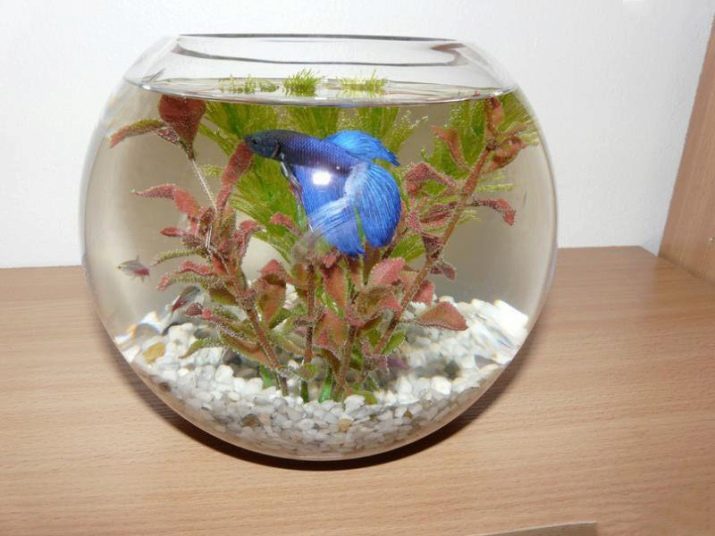
What to feed?
Feeding your fish is not a problem as they eat almost any food. There are different types of food: dry, live and frozen. The proportion of live food should be higher in the diet of fish, since they need protein food.
They gladly eat bloodworms and tubifex, daphnia and cyclops, zooplankton and even snails, as well as crushed ordinary earthworms.
The disadvantage of animal food is that it can contain harmful microbes that cause various diseases in males.
Frozen - the same live food, but frozen. It is safer, as it does not contain harmful bacteria, unlike live food. Store it in the freezer and, if necessary, separate the right amount for feeding. You cannot defrost and re-freeze food: it may deteriorate.
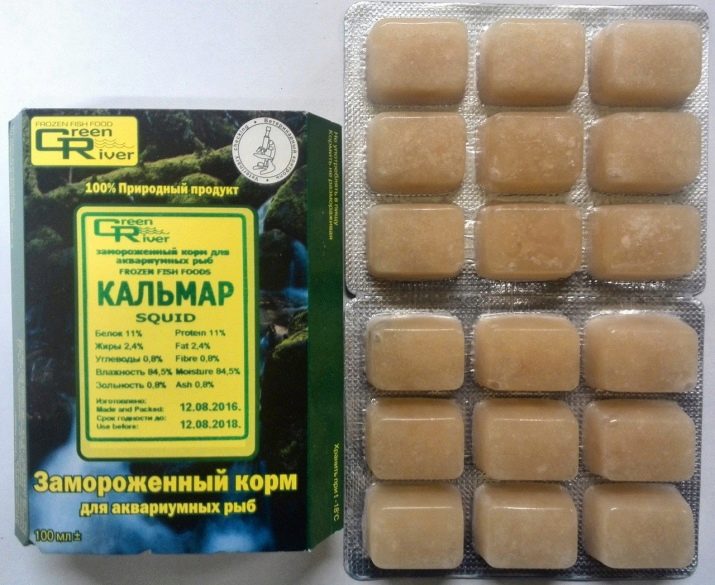
Dry food is in the form of small granules or flakes. It is recommended to give it less frequently than live and frozen. Dry food is given according to the priority table.
- Regular cereal food is given in such a small amount that it can be eaten by males in about 2 minutes.
- Special (for cockerels) granulated food - it can be given daily. It contains properly balanced beneficial elements.
- Tubifex, bloodworms, dry brine shrimp.
Different types of feed should not be given in one feeding: for example, frozen food and dry food, or combine different types of dry food at the same time. You need to adhere to the rule: one feeding - one type of food.
To prolong life and preserve the bright color of the cockerels, they need to be fed a variety of food, which must be alternated.
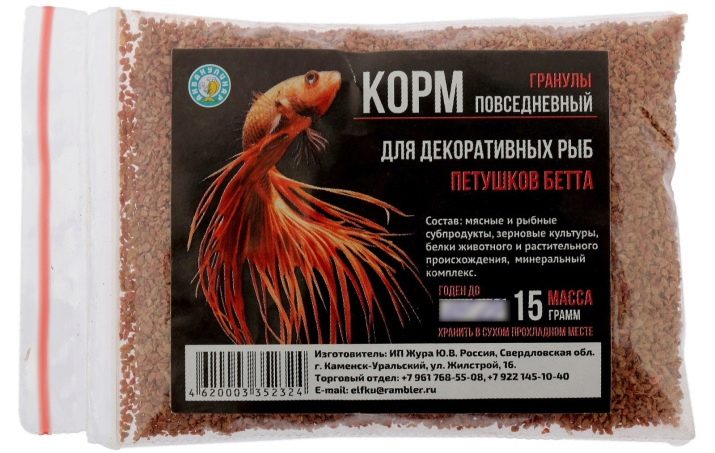
You can supplement the diet of a rooster with frozen shrimp meat, live insects and their larvae, spinach leaves, lettuce, pre-scalded.
It is required to feed the cockerels 1 or 2 times a day. Adult fish can be fed less often, 1 meal is enough. During spawning, food is given twice a day, and the fry are also fed. Feed is given at the same time. The fish will gradually develop a reflex, and they will collect themselves near the feeders by the time of feeding.
The amount of feed should not be large: males should eat it in about 2-5 minutes. Live food is given in the amount of 3-5 worms, and 4-6 pellets are required. in one feeding. Leftover feed should be removed so that it does not contaminate the water in the container.
It is not recommended to overfeed the fish: this leads to their obesity. It is necessary to arrange one fasting day without feed every week.

How to take care of it properly?
Although simple, but correct care is required for the cockerels. Let's consider the basic requirements of their content.
- A properly equipped aquarium with a volume of water from 3 (for one individual) to 10-20 liters for several males.
- Optimal temperature conditions. The water temperature in the container should be approximately +24. +28 degrees Celsius. Fish can tolerate a lower temperature well, but it should not be lower than +18.
- Besides fish cannot stay in cool water for a long time: from this they can develop various diseases. The temperature must be constantly monitored with a thermometer.
- Water composition. Males are undemanding to the quality and composition of the water, but it is desirable that the hardness is from 4 to 15 dGH, and the acidity reaches about 6-7.5 pH. To prevent diseases, stress conditions and strengthen the color of fish, it is advisable to add special aquarium salt to the water (0.5 teaspoon per 2-3 liters of water).
- Periodic water change. In large containers, the water needs to be changed after 14 days, in small containers - every 3 days. You can change the water in two ways: three times a week, replace only 1/4 of the total volume of the container; fish are transplanted into a separate container and replace all the water in the aquarium. Clean tap water is preliminarily allowed to stand for two days. It is strictly forbidden to use distilled water, since it does not contain substances beneficial to fish, and bottled water.
- Simultaneously with the water change, the aquarium is cleaned. The bottom is cleaned, and all the remaining food is removed, the walls and decor are cleaned. A bacterial film often forms on the water surface. It prevents the air necessary for males from entering the water.
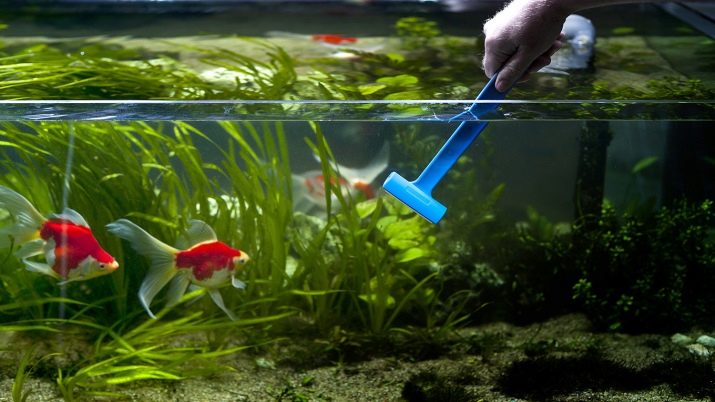
Because bettas are labyrinth fish, they periodically rise to the surface to swallow air. Therefore, a clean water surface is so necessary.
The film is removed with a special tool or simply using a paper sheet. And also all the plants that have appeared are removed from the surface.
- Lighting should be diffused. The backlight must be turned off at night.
- The presence of an aerator is necessary only in large containers: without it, the water at the bottom will be colder than at the surface.
It is believed that round aquariums and large jars are not entirely suitable for the normal life of bettas. The view is distorted in them, which leads to disorientation of the males.
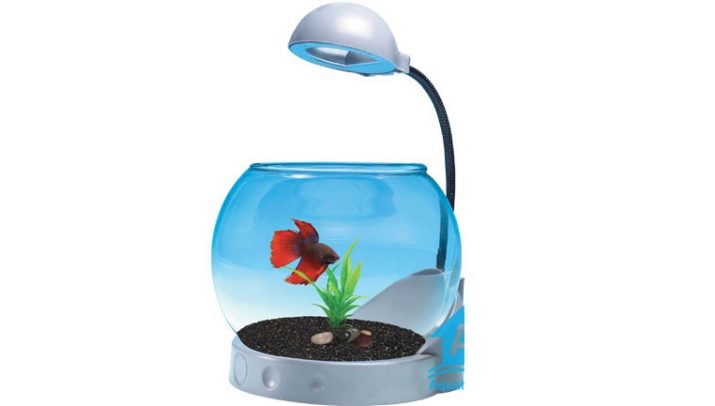
In addition, round walls are much more difficult to clean. Usually such containers are not large enough and are suitable for keeping only one fish.
Taking care of fish in a round container is the same as usual: periodic water changes, washing the aquarium and decor, caring for aquatic plants, which consists in cutting off dead parts.
When washing the container, do not use soap or any cleaning agents. Their residues can dissolve in the water and lead to chemical poisoning of the fish.

Possible problems
When breeding cockerels, some problems can arise, and first of all this is due to diseases.
One of the most common diseases is fin rot. It is caused by bacteria that result from poor maintenance (eg dirty soil). The disease manifests itself as follows: the ends of the tail and fins darken, the fins sink, white spots appear on the body, the activity of the fish decreases.
When such signs appear, an urgent need to clean the aquarium: the elements of the artificial decor must be boiled, the container must be washed using a weak bleach solution. Then the container is filled with clean water, to which a drug (tetracycline, ampicillin) or any antifungal agent is added.
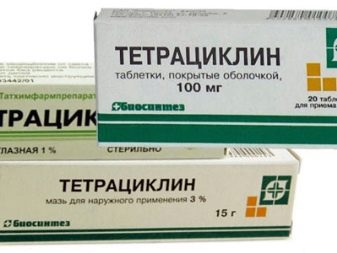
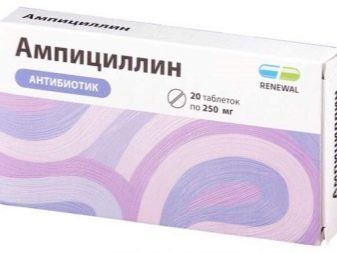
The water with the addition of the drug should be changed after 3 days until the fish improve. The treatment can take a whole month. At the end, the container is processed by Betamaks to prevent the return of the disease.
Velvet disease is another common disease. With this disease, fish scales become covered with a reddish bloom, which is especially clearly visible in the light. The fins of the cockerels can stick together, the fish rub against the glass of the aquarium, become lethargic, and their appetite disappears.
For treatment, use the drug BettaZing (3 drops per liter of water).
To prevent the disease, it is recommended to add a special conditioner and salt for aquariums to the water.
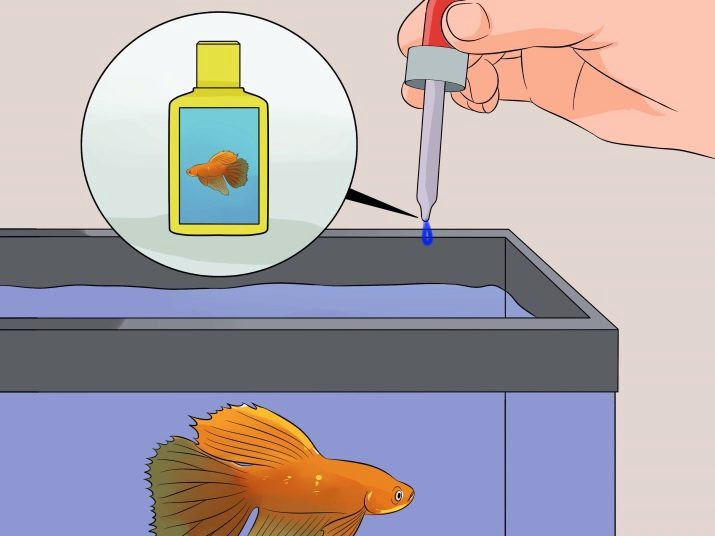
The disease of ichthyophthyriosis is accompanied by the appearance of white bulges on the body. The cause of the disease is parasitic ciliates. For treatment, sea or common table salt is used by adding it to water. In such water, parasites die quickly (in about a day).
Sometimes, males show changes in their behavior. The fish sink and lie at the bottom for a long time for these reasons:
- transferred stressful condition;
- the temperature of the habitat is much less than +18 degrees;
- chemical poisoning.
Males swim near the surface for a very long time and try to jump out if the water contains a large amount of chlorine. This problem can be solved simply: the water must be heated up to +90 degrees.
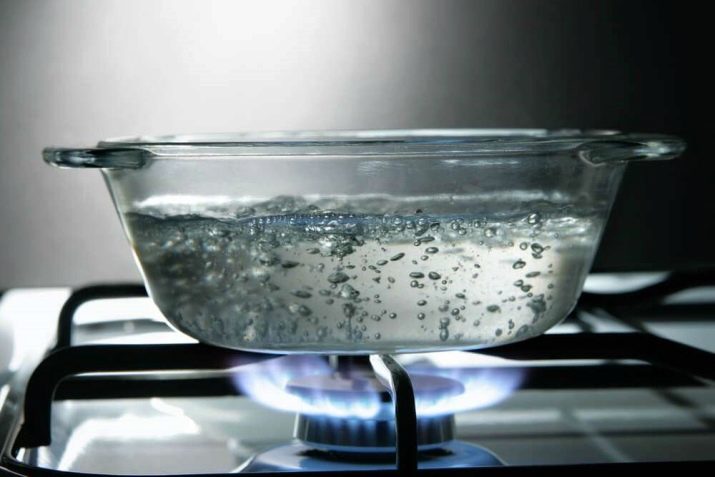
Breeding rules
Sexual maturation in these fish begins as early as 3-4 months of age. However, it is desirable to select 6-8 month old individuals for reproduction. The difference between a male and a female is well expressed: it is distinguished by a brighter color and longer fins, as well as a slender and larger body.
In females, the size of the fins is smaller, dark stripes are clearly visible on the body, and there is a spot of white tint near the tail that appears at 3 months of age.
Breeding these fish at home requires following simple rules.

First of all, this is the equipment of the spawning grounds. For him, a container with a volume of 3-4 liters is selected and filled with water about 15 cm.The soil is not placed on the bottom, but 1-2 live small-leaved plants are placed, a grotto or other shelter for the female is arranged, where she will hide from the male, since he often aggressive during the spawning season.
A also install diffused lighting and aerator.
Water is used settled (3-4 days) and warm, approximately +28.30 degrees Celsius.
Before spawning, in about 10-14 days, future parents are transplanted into separate containers to prepare for breeding.
While feeding the fish, the volume of live and frozen foods containing a large amount of protein is increased in their diet. This is necessary to prepare for spawning and the formation of eggs and milk.

During this period, the water is slightly warmed up (by about 2 degrees), and it is changed more often.
- First, one male is placed in the spawning grounds. The readiness of the male for spawning is determined by its color, which becomes more intense, and also begins to release a large number of bubbles. Here he creates a spawning nest, holding together air bubbles and small parts of plants with his saliva.
- The female is placed next to the male after building the nest. It's time for spawning. The cockerel begins to pursue the female, and, having overtaken and wrapped around her, squeezes out the eggs.
- Then the male picks up the falling eggs with his mouth and places them in the bubbles of the nest. This is repeated until the selection of eggs is completed.
The end of spawning is indicated by the fact that the cock is swimming over the nest, and the female is swimming in the shelter.
At the end of spawning, the female is returned to a regular aquarium. The cockerel stays in the spawning grounds and nurses future fry.
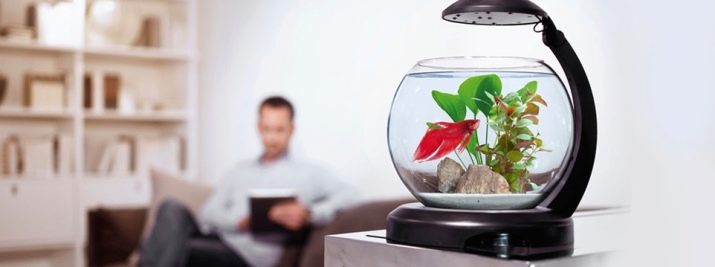
Often during incubation, eggs that have become heavy fall out of the nest. The cockerel picks them up and returns them to their place. So that the male does not sleep at night, but takes care of the eggs, it is necessary to place a lamp above the nest.
The incubation process lasts about two days, then larvae hatch from the eggs. For 3-4 days, their food is carried out at the expense of the yolk sac reserves. Then, as soon as the bag disappears completely, the grown fry leave the nest and begin to search for food.
The time has come for the male to return to the regular aquarium. Fry should be fed with "live dust", rubbed with yolk, as well as brine shrimp and small crustaceans (cyclops). It is not recommended to use dry food, as it negatively affects the development of fry.

At the moment, light aeration should be connected. By the age of one month in fry, the process of development of the labyrinth organ is completed, and from this time on, aeration must be stopped.
When the fry reach 3 months of age, they are sorted and placed in different containers so that the large ones do not eat the small ones.
The fry are deposited when they begin to show aggression and attack each other.
From now on, they need care like adults.
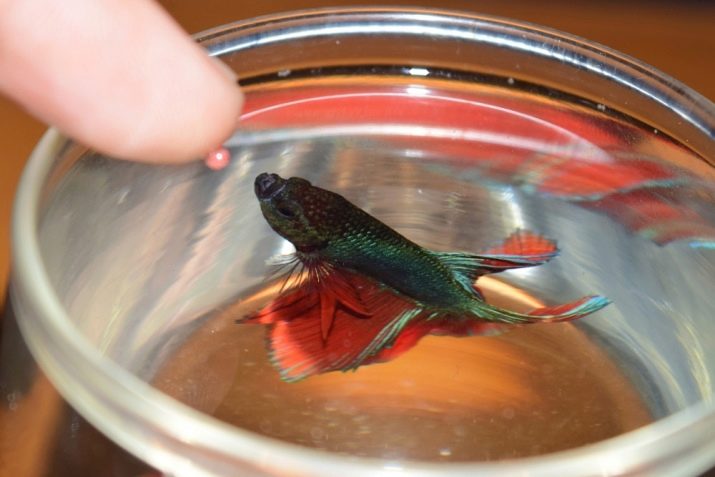
Compatibility with other fish
In the natural environment, males come into contact exclusively during spawning. The compatibility of these fish with their relatives in an aquarium is of a subjective nature. Their relationship is often influenced by the temperament of the fish.
Often males cannot stand the neighborhood of not only another cock, but also females. However, individual females themselves pose a threat to the unwanted male. Therefore, keeping several individuals of cockerels will require large aquariums, divided into several compartments.
According to compatibility with fighting fish, other fish species are divided into three groups.
- Good compatibility. This group includes small-sized peace-loving fish: swordtails and peaceful catfish, platies and thorns, mollies and rasbora, as well as grumbled gourami and minors.
- Satisfactory compatibility with infrequent and minor contractions. This group includes the following species: guppies and barbs, neons and cardinals, spotted gourami and labeo.
- Complete incompatibility with astronotuses and lineats, piranhas and akars, parrots.
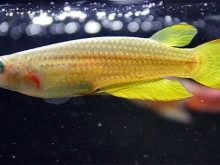


The cockerels will gladly eat the shrimps that live with them. Small snails are also the subject of their hunt.
It is recommended to populate the aquarium with different types of fish at the same time: this way they will get along faster and come to terms with each other. It should also be noted that the cockerel, getting used to its neighbors, can get stressed if they are seated.
Despite its fighting nature, the cockerel fish may well decorate any aquarium and coexist with other representatives of fish.
For tips on keeping males, see the next video.









The aggressiveness of the cockerels, it is not clear why, is greatly exaggerated: in my 120-liter aquarium, seven cockerels (two males and five females), six macropods, five honey gourami and two pairs of ramirezi apistograms live perfectly.